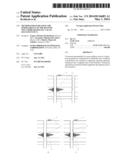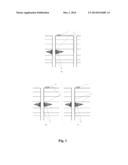Patent application title: METHOD FOR INCREASING THE PERMEABILITY OF THE BOTTOM WELL-BORE REGION OF A SEAM (IS11.0138-US-PCT)
Inventors:
Evgeny Nikolaevich Dyshlyuk (Moscow, RU)
Alexander Nilkolaevich Nadeev (Moscow, RU)
Dmitry Olegovich Tailakov (Kemerovo, RU)
Assignees:
SCHLUMBERGER TECHNOLOGY CORPORATION
IPC8 Class: AE21B4326FI
USPC Class:
166248
Class name: Wells processes electric current or electrical wave energy through earth for treating
Publication date: 2014-05-01
Patent application number: 20140116683
Abstract:
To increase permeability of a near-wellbore zone of a formation an
operation on stimulation of a fluid flow into a wellbore is performed,
the operation comprising injecting chemical substances into a targeted
zone of the formation. During the stimulation an electrical field is
applied to the targeted zone of the formation.Claims:
1. A method for increasing permeability of a near-wellbore zone of a
formation, comprising: injecting chemical substances into a targeted zone
of the formation to stimulate fluid flow into a wellbore, and applying an
electrical field to the targeted zone of the formation.
2. The method of claim 1, wherein the chemical substances comprise an acid formation treatment.
3. The method of claim 1, wherein the injecting comprises hydraulic fracturing of the formation.
4. The method of claim 1, wherein during the injecting, an additional treatment is applied to the targeted zone of the formation, the additional treatment is selected from a group consisting of magnetic, thermal, acoustic, and a combination thereof.
5. The method of claim 1, wherein the electrical filed is applied by electrodes, at least one of the electrodes is disposed in the wellbore on the level of the targeted zone of the formation.
6. The method of claim 5, wherein one of the electrodes is disposed on the surface.
7. The method of claim 1, wherein the electrical filed is applied by electrodes, one of the electrodes is disposed lower than the targeted zone of the formation while the other electrode is disposed higher than the targeted zone of the formation.
8. The method of claim 1, wherein the electrodes comprise casing and tubing.
Description:
CROSS-REFERENCE TO RELATED APPLICATIONS
[0001] This application is a U.S. National Stage Application under 35 U.S.C. §371 and claims priority to Patent Cooperation Treaty Application Number PCT/IB2012/000282 filed Apr. 13, 2012, which claims priority to Russian Patent Application No. 2011115860 filed Apr. 22, 2011. Both of these applications are incorporated herein by reference in their entireties.
FIELD
[0002] The invention is related to the well services in oil-field industry, particularly, to the methods for increasing permeability of a near-wellbore zone of a formation by stimulation of a fluid inflow into a wellbore.
BACKGROUND
[0003] A stimulation of a fluid inflow into a wellbore is required to recover and improve the near-wellbore zone filtration characteristics, basically through improved permeability of the near-wellbore zone and reduced fluid viscosity. Among the most efficient methods of the stimulation of fluids' influx from a formation are acid treatment and formation hydraulic fracturing (see, for example, V.I. Kudinov, Osnovy neftegazopromyslovogo dela (Foundations of Oil and Gas Formation Industry), Moscow, 2005, pp. 428-429). Acid treatment and formation hydraulic fracturing enable stimulation of a fluid inflow into a wellbore by creating high-permeable paths for the fluid inflow into the wellbore hereby the selection of a specific treatment method and a quality of the works completed are critical for the efficiency of the future well operation. Thus, incorrectly performed fluid inflow stimulation may, for example, result in the need to completely stop the future wellbore operation. To intensify the fluid inflow during the matrix treatment and formation hydraulic fracturing various liquid and solid chemicals are injected into a wellbore. Thus, during hydraulic fracturing various substances are injected into a wellbore under large pressure which results in cracks in the rock. To prevent a closure of the cracks in the rock solid particles are injected into the wellbore using a viscous gel--propping agent (proppant). Due to high viscosity of the gel the crack becomes low-permeable and to improve its permeability, as a rule, reverse recirculation is used. To reduce the gel viscosity different chemicals--breakers--are added to the solution and, when penetrating the formation, they can reduce the gel viscosity. The chemicals being added are, as a rule, expensive, but not always efficient. Besides, engineers normally are not able to impact the breakers' activity after the chemicals have been injected into the wellbore. Therefore, among the key disadvantages of the existing methods for increasing the near-wellbore zone permeability are high costs, low speed and inability to monitor the reaction speed after the chemicals have been injected into the wellbore.
[0004] The proposed method provides for increased reliability and efficiency of stimulating a fluid inflow into a wellbore, enhanced speed of stimulating with simultaneous reduction of the risk of incorrect performing thereof as well as reduced costs.
SUMMARY
[0005] The method comprises carrying out a stimulation of a fluid flow into a wellbore comprising injecting chemical substances into a targeted zone of a formation and applying an electric field to the targeted zone of the formation.
[0006] The stimulation of the fluid flow into the wellbore is an acid formation treatment or a hydraulic fracturing of the formation.
[0007] Additional magnetic, thermal, acoustic treatment or a combination of thereof can be applied to the targeted zone of the formation zone during the stimulation.
[0008] The electric filed can be applied by electrodes. At least one of the electrodes is disposed in the wellbore on the level of the targeted zone.
[0009] One of the electrodes can be disposed in the wellbore on the level of the targeted zone and the other electrode can be disposed on the surface.
[0010] One of the electrodes can be disposed lower than the targeted zoned of the formation while the other can be disposed higher than the targeted zone of the formation being treated.
[0011] Casings and tubing can be used as the electrodes.
BRIEF DESCRIPTION OF THE DRAWINGS
[0012] The invention is explained by a drawing (FIG. 1) showing a system providing an electric impact onto a formation in which stimulation of the fluid inflow is performed.
DETAILED DESCRIPTION
[0013] The proposed method is based on applying an electric field to a formation in which stimulation of a fluid inflow is performed. The effect of the electrical stimulation depends on physical parameters of the formation and is determined by positioning of electrodes, value and frequency of the electric field being created as well as a power of a power supply being used. The electric impact causes enhancement of physico-chemical processes in the formation and in space inside a wellbore during the stimulation of a fluid inflow into the wellbore. Thus, for example, the electric field causes the appearance of electric currents as well as an electro-kinetic, phenomena like electroosmosis or electrophoresis. These phenomena result in the motion of charged particles and the fluid and therefore result in the intensification of current physico-chemical processes. Additional application of magnetic field promotes additional motion of the charged particles. Extra temperature heating also causes the intensification of physico-chemical processes in the area being heated through intensification of the substances' thermal diffusion. Additional acoustic impact using a sound-emitting device also enhances the physico-chemical processes due to additional oscillations of the particles caused by the sound wave passage. Hereby any of the impacts above may be applied locally or directionally which enables intensification of the physico-chemical processes (such as chemical reaction speed) in the required area.
[0014] A system that allows to create an electric field inside a wellbore and a formation is shown on FIG. 1 where 1 is a current and voltage generator, 2--electrodes connected to the current and voltage generator 1, 3--a targeted zone of the formation in which stimulation of a fluid inflow is performed, chemicals have been injected into this targeted zone 3. For creating the electric field different combinations of electrodes positioning in the wellbore are possible, but at least one of the electrodes should be disposed in the wellbore at the level of the targeted zone 3 being treated. The other electrode may be located in an adjacent wellbore (see FIG. 1a) or on the surface (see FIG. 1b). The electrodes may also be disposed in the wellbore above and below the targeted zone 3 being treated (see FIG. 1c). Casings and tubings may also be used as electrodes. A source of magnetic field can be placed into the wellbore at the level of the targeted zone 3 being treated. If a sound emitting device and/or a thermal heater is used they also can be disposed in the wellbore at the level of the targeted zone 3 being treated. Different components of the instruments used may be located both on the same device and on different and their power may be supplied by a cable or by batteries or accumulators.
[0015] As an example, three series of experiments were conducted in order to check the feasibility of described method. These experiments were carried out at room temperature 22° C. (72° F.). For the first experiment 750 ml of YF130LGD gel was prepared and put into a tank with plane electrodes attached thereto. The electrodes were connected to a standard power generating unit with AC output of 100V at ˜50 Hz. The distance between the electrodes was about 10 cm. After 15 minutes, only a slight gel destruction near the surface of the electrode was observed. That can be a result of local temperature increase up to 80° C. (180° F.) near the electrodes. The temperature was measured immediately after power was off.
[0016] For the second experiment two samples of YF130LGD hydraulic-fracture gel were prepared (500 ml each) and 2 g of J218 breaker was added to each gel sample. J218 breaker concentration for YF130LGD gel destruction is about 10 pounds/1000 gallons (1,2 kg/m3) that is two times lower than for carrying out this experiment. But it should be mentioned that the breaker operation temperature range is 52-107° C. (125-225° F.), moreover, the breaker is activated by adding special chemical catalysts. One sample of the prepared gel with the breaker portion was placed into a tank without electrodes and thoroughly mixed. The other sample was placed into the system with electrodes. After 7 minutes of AC applying it was detected that almost all gel (90%) in the tank under voltage was destroyed (the gel viscosity reduced to water viscosity value). In the tank without AC application only 10-15% gel was destroyed. During the second experiment the temperature value was 95° C. (200° F.) on the electrodes and 35° C. (95° F.) in the centre of the tank after 7 minutes of the AC impact.
[0017] The third experiment was performed to prove that at high temperatures there will be no gel destructions. For this purpose 500 ml of YF130LGD gel mixed with 2 g of J218 breaker was prepared and placed into a pre-heated tank, and then into an oven at 100° C. (210° F.). After 15 minutes of the temperature action destruction of maximum 25-30% of gel was noted.
[0018] Comparing the results of electrical field and temperature impact in presence of breaker, the advantage of the electrical field impact for the gel destruction becomes evident.
User Contributions:
Comment about this patent or add new information about this topic:


